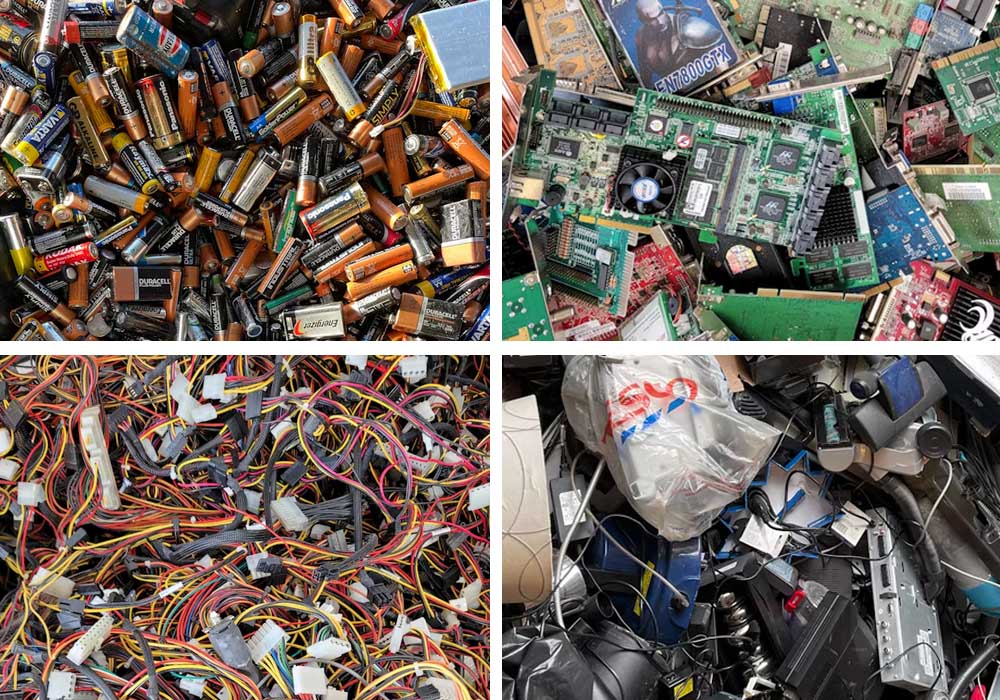PCB Sorting Machine
Battery Sorting Machine
Wire Sorting Machine
Cable Sorting Machine
Plastic Metal Sorting Machine
Circuit Board Sorting Machine
Small Appliance Sorting Machine
Mobile Phone Sorting Machine
LED Sorting Machine
Aluminum Copper Radiator Sorting Machine
What is E-waste Sorting
E-waste sorting refers to the process of separating and categorizing electronic waste into different components for recycling or disposal. As electronic devices become more prevalent, the need for efficient e-waste management has grown significantly. Sorting solutions help recover valuable materials like metals, plastics, and rare earth elements while ensuring hazardous substances are properly handled.
Modern e-waste sorting utilizes advanced technologies such as sensors, AI, and automated systems to accurately identify and separate materials. This process is crucial for reducing environmental pollution and promoting sustainable resource recovery in the electronics industry.

How E-waste Sorting Works
1 Advanced Material Detection
Combines X-ray fluorescence and infrared spectroscopy with our proprietary color recognition technology to identify e-waste components with 99.2% accuracy.
2 Multi-Layer Component Analysis
Our deep scanning technology penetrates surface layers to detect hidden precious metals and hazardous materials within complex PCB assemblies.
3 AI-Powered Sorting
Machine learning algorithms continuously improve material recognition, adapting to new e-waste streams and achieving 96% purity in sorted output.
4 Selective Ejection System
Features programmable ejection modules including precision air jets (for light materials) and robotic arms (for heavy components) with 0.05mm positioning accuracy.
The e-waste sorting process begins with the collection and preliminary separation of electronic components. Machines then use various detection methods such as X-ray fluorescence, infrared spectroscopy, and color recognition to identify different materials. These technologies enable the system to distinguish between various types of plastics, metals, and other components with high accuracy.
After identification, the sorting machines separate materials using different mechanisms like air jets, mechanical arms, or conveyor belt diversions. The sorted materials are then sent for further processing or recycling, completing the circular economy loop for electronic products.
Core Features and Advantages of E-waste Sorting
Modern e-waste sorting machines offer high-precision separation capabilities that significantly outperform manual sorting methods. They can process large volumes of waste quickly and efficiently, with some systems achieving sorting accuracies above 99%. This level of precision ensures maximum material recovery while minimizing cross-contamination between different material streams.
The automation of e-waste sorting provides multiple advantages including reduced labor costs, improved worker safety, and consistent quality output. These systems can operate continuously for extended periods, making them ideal for large-scale recycling operations. Additionally, they help companies comply with increasingly strict environmental regulations regarding e-waste management.
Technical Specifications of E-waste Sorting Machines
E-waste sorting machines typically feature processing capacities ranging from 1 to 10 tons per hour, depending on the model and application. They incorporate multiple sensor technologies including near-infrared (NIR), color recognition, and metal detection systems. The machines operate at various power requirements, usually between 10-50 kW, with some high-capacity industrial models requiring three-phase power supply.
Advanced models include intelligent recognition systems that can identify and sort thousands of different material combinations. They often feature modular designs allowing for customization based on specific sorting needs. The machines are built with durable materials to withstand the harsh conditions of e-waste processing environments, ensuring long service life with proper maintenance.
Applications of E-waste Sorting
E-waste sorting machines find applications across various sectors including electronics recycling facilities, municipal waste management centers, and specialized e-waste processing plants. They are essential for handling discarded computers, mobile phones, household appliances, and other electronic devices. The sorted materials are then reused in manufacturing or properly disposed of if hazardous.
Specialized sorting machines exist for different e-waste components such as PCBs, batteries, wires, and various metal-plastic combinations. These targeted solutions ensure optimal recovery rates for specific materials while maintaining processing efficiency. The technology continues to evolve to address emerging challenges in e-waste management.
Buying Guide
When selecting an e-waste sorting machine, consider the types of materials you primarily need to process and the required throughput capacity. Evaluate the machine's sorting accuracy, energy efficiency, and maintenance requirements. It's also important to assess the vendor's after-sales support and availability of spare parts.
Look for machines with upgradable software to accommodate future technological advancements. Consider the footprint of the equipment and whether it can integrate with your existing processing line. Request demonstrations and references from current users to ensure the machine meets your specific operational needs.
Maintenance Guide
Regular maintenance is crucial for optimal performance of e-waste sorting machines. Establish a routine cleaning schedule to prevent material buildup that could affect sensor accuracy. Follow the manufacturer's guidelines for lubricating moving parts and inspecting wear components like belts and bearings.
Keep software and firmware updated to benefit from the latest sorting algorithms and performance improvements. Train staff to recognize early signs of equipment issues and establish a relationship with certified technicians for more complex repairs. Proper maintenance not only extends machine life but also ensures consistent sorting quality.